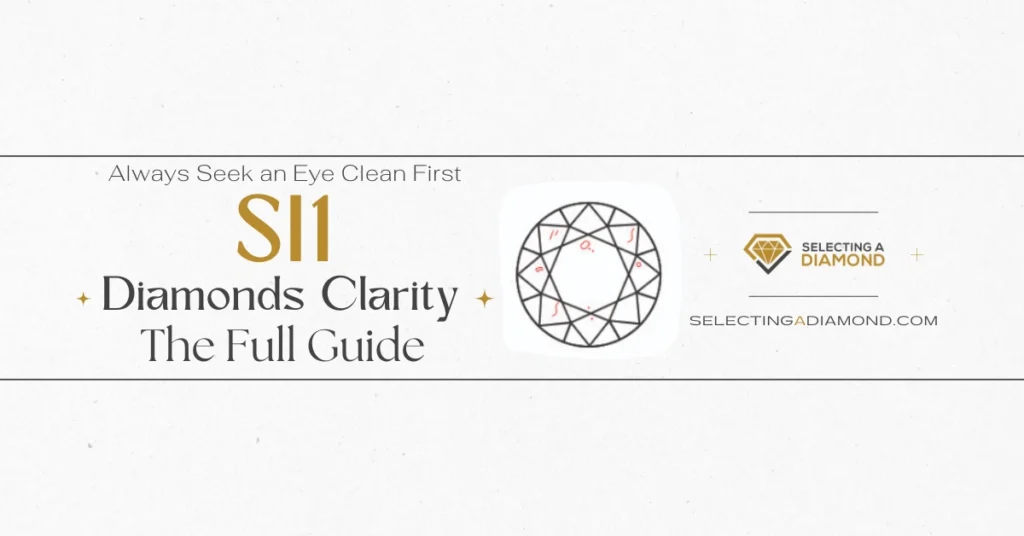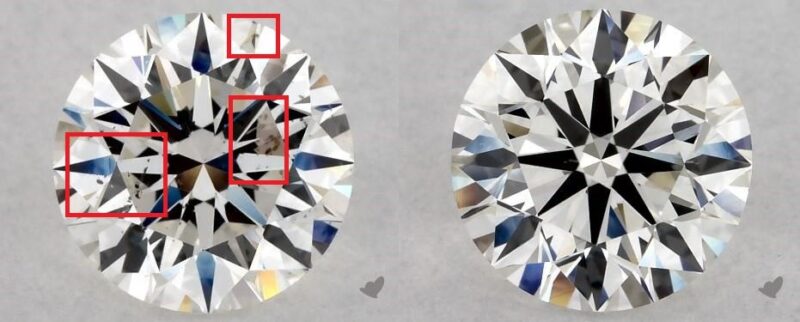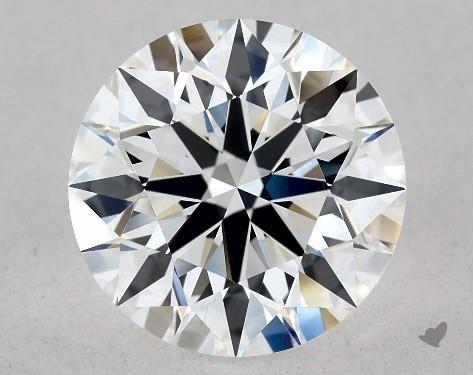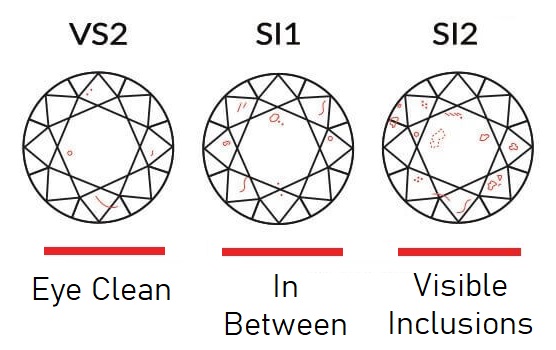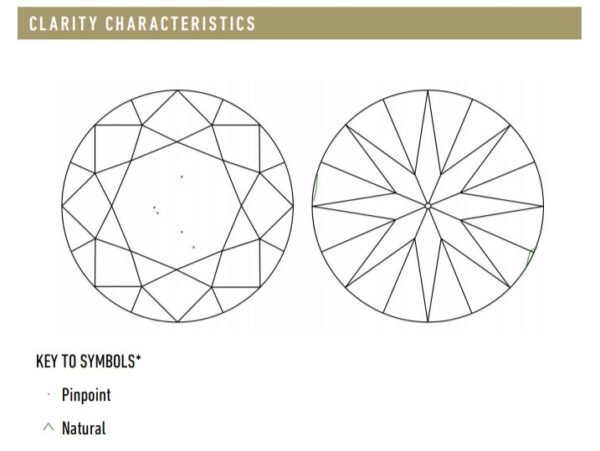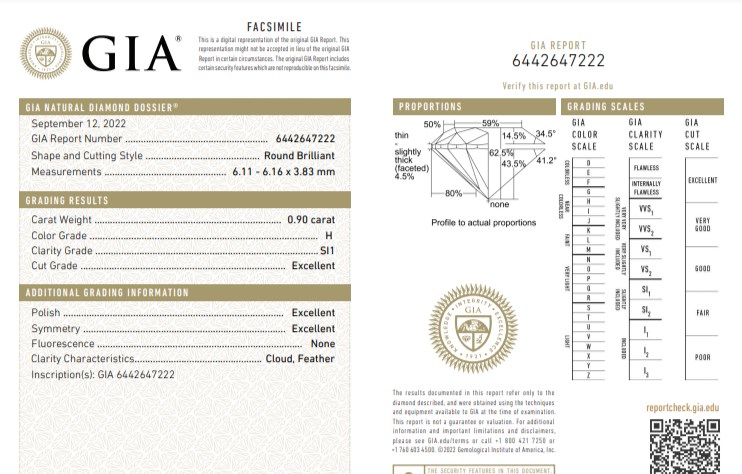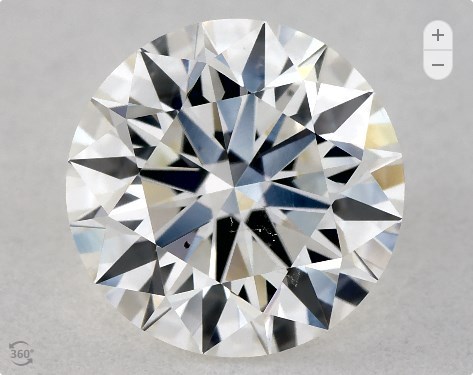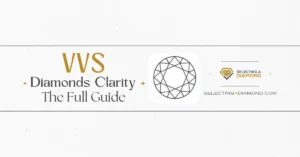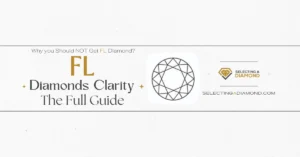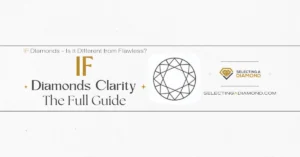Summary in a few lines:
SI1 diamonds clarity is the most controversial clarity grade when it comes to whether it’s an eye clean and safe to buy, or it has visible inclusions affecting diamond’s beauty and brilliance.
The “conflict” is heavily supported with proofs for each point of view, so for example, here is a nice, clear, and eye-clean SI1 on James Allen, and on the other hand, here is another SI1 diamond (excellent cut as well), but has a lot of inclusions that you probably can see them with naked eye.
Note the price difference, a bit less than $200!
In short, SI1 clarity grade is a great starting point for most diamonds around 1 carat or less, their inclusions are so tiny that they won’t be visible to naked eye.
That’s why in most cases it will be the best budget-friendly clarity grade, where you guarantee paying for only what you can see, with a guarantee to have a great diamond.
Want to see yourself? Here is a pre-defined search on James Allen, filtered for SI1 clarity and other some other characteristics, most of these diamonds you see are eye clean (keep in mind, you’re seeing them under 20x magnificent magnification technology).
Let’s get into some details.
What is SI Clarity Group? SI1 & SI2 Standing on Clarity Chart
SI (1&2) in clarity grade stands for ‘Slightly Included’; Included refers to the inclusions found on the diamond (under 10x magnification as per GIA definition), whether they’re visible to the eye or not.
When it comes to clarity grade, amount, size, and the types of inclusions determine if a particular diamond is SI1 or VS2 (or any other grade in general).
Pro Tip: Generally, it’s common to refer to any imperfection on the diamond as “inclusion”, while there is a main difference between inclusions & blemishes:
Inclusions are these birthmarks which are internal (haven’t reached the diamond surface), while blemishes are -obviously- external birthmarks (on diamond surface).
GIA, as the leader grading lab in the diamond industry, created a clarity grading chart to categorize/group diamonds into a scale of six categories and eleven grades based on how visible inclusions are in a diamond (again, under 10x magnification).
Between the 11 grades, the SI1 (slightly included) is probably the most discussed grade and the cause of 90% of debates on diamonds clarity.
Here is a quick overview of the 6 groups & 11 grades of diamond clarity chart:
Note: SI3 level is not adopted by major certification labs like GIA. It was actually introduced by EGL for the sake of sellers and not buyers, read here how and why.
Some people (90% of them are salespeople) say that SI1 has a lot of inclusions to the limit that you can identify with your naked eye, others -however- say it’s considered an eye clean grade! And some are in the middle!
These two diamonds you see here are identical in terms of general characteristics known as the 4Cs including the clarity, both are SI1:
Both diamonds have the same polish & symmetry grades as well, unbelievable, isn’t it?
Well, let’s now take a deeper look (20x or even 40x) at both of them, here is the first one to the left, and this is the one to the right to understand the difference.
Maybe images on James Allen are a “too revealing” and expose a lot of unseen inclusions, take a look for example on this beautiful 0.9 SI1 diamond on Blue Nile, it’s clearly clear that inclusion are much harder to see when inspecting using naked eye, or standard zoom technologies.
If we figure out that, then we can definitely understand why the SI1 is a very, how can we say that, a problematic grade for many people!
SI1 vs SI2
The primary distinction between these two grades is that an SI2 diamond’s inclusions are likely to be visible to the naked eye. These inclusions could potentially impact the diamond’s brilliance and durability. Conversely, in an SI1 diamond, inclusions are likely not visible to the naked eye, and even if they are, they’ll have less impact on the diamond’s brilliance and durability.
For a visual comparison, it wouldn’t be entirely fair since both grades could potentially house eye-clean and non-eye-clean diamonds. For a general idea, you can browse on platforms offering advanced imaging technologies like Whiteflash and James Allen.
SI1 vs VS2
Looking at the GIA definition for VS (1 & 2) grades, it reads:
“Inclusions are minor and range from difficult to somewhat easy for a skilled grader to see under 10x magnification.”
For SI (1 & 2), it states:
Inclusions are noticeable to a skilled grader under 10x magnification.
Given that each group contains two grades, it’s safe to conclude that VS2 has inclusions that are “somewhat easy” to spot, and SI1 inclusions are noticeable (to some degree) under 10x magnification for a skilled grader.
Are SI1 Diamonds Eye Clean?
When it comes to diamond shopping, we typically advise focusing on finding diamonds that are “eye clean” instead of focusing solely on a particular clarity grade. SI1 is an excellent clarity grade to begin your search with.
In short:
Around 95% of SI1 diamonds less than 1 carat are eye clean.
SI1 clarity grade ranks seventh on the diamond clarity scale in terms of purity and the absence of inclusions or blemishes under 10x magnification.
The story differs when examining diamonds without magnification. Most people, relying solely on their naked eyes, would find it exceedingly challenging to detect inclusions (if any) under ordinary conditions.
For instance, in a smaller diamond such as this beautiful 0.7 carat SI1 from James Allen, you would not detect any inclusions with your naked eye. The 360 HD images you see here are magnified 20x.
In all fairness to the ongoing debate, we should illustrate both sides of the SI1 diamond argument.
Take these two diamonds as an example. They are identical in terms of the universally accepted 4Cs, which include clarity (both are SI1). They even share the same polish and symmetry grades—surprising, right?
Now, let’s zoom in (20x or even 40x) on each of them. Here is the first one on the left, and the second one on the right. This will give you an understanding of the difference.
Realistically speaking, the images on James Allen tend to be “too revealing,” exposing a lot of otherwise unseen inclusions.
Why Higher Clarity Grades Are Insanely Expensive?
The end goal of all of this reading and researching is to help you in your quest of finding the right diamond for you or your loved one, and of course, for the best budget you set!
We believe that in order to make the best buying decision, you’ll need to be clear on the diamond facts that matter, and it requires that you have at least a basic understanding of the different types of diamonds on the market and their characteristics (4Cs).
While diamond market experts would easily tell you that the best diamonds are the flawless (FL) & internally flawless (IF) diamonds with no inclusions at all, they may not state that there are great diamond clarity alternatives other than the perfect FL’s and IF’s, and not even close to these grades!
Look at this image, for example, this is an Internally Flawless True Hearts diamond on James Allen, priced at $30k, which is almost DOUBLE the price of the same characteristics for a VS2 difference (like this one):
If you inspect it under the 40x superzoom or a 360-HD image that James Allen provides, you will not be able to detect any inclusion, and that’s what flawless means.
Flawless and Internally Flawless diamonds are very rare; they both sum up to almost 3% of diamonds globally, and if that tells us something, it’s why they are extremely expensive in comparison with the other clarity grades!
But does this mean that to get a clean diamond, you have to step up to that level?
This blog is designed for you to not feel regret after your purchase and most importantly to be rest-assured that you have done all the research that could be done to get the best option there for your budget!
Many people have had to ignorantly spend way higher than their normal budget, even when they could have gotten something that is at a lower price (and still a good option).
Although the best diamonds sometimes are worth investing your money in, yet, you could also get other diamonds with some imperfections that do not, however, spoil the fundamental expectation of what people want in a sparkling diamond, at all.
Eye Clean vs Visible Inclusion Clarity Grades
Disclaimer: This is not an official grouping at all, it’s only for the sake of having a quicker and better understanding of our SI1 anatomy here.
Keep in mind that this grouping makes sense only when you’re considering the clarity of diamonds using the naked eyes.
Let’s divide clarity grades into 2 groups based on this, we have the following:
- Diamonds without visible blemishes (Eye clean)
- Diamonds with visible blemishes (Not eye clean)
Some diamond analysts and experts agree that it is always better not to go for diamonds with any sort of inclusions, like simply avoid them all!
This really means ignoring more than 97% of diamonds on earth! This is a pre-set search for Flawless & Internally Flawless diamonds on James Allen, it clearly shows you that you’re only looking at 14000 out of 544000 diamonds, around 2.5%!
Diamonds with blemishes have reasonably reduced aesthetic appeal -depending on the amount of observed blemish- to the eye, in fact, the more blemish or less clarity on a diamond sample, the less value it would have in the market.
Therefore, it’s not really reasonable to restrict our diamond use specifications to the FL (because of a list of factors including the huge price traits).
The extra price difference you’re paying when getting a very high clarity grade (whether FL, IF, even VVS grades) is for something that you can NEVER tell (by just looking) at the diamond with the naked eye.
So, you can be saving yourself more bucks if you go a little lower in clarity grade. Let’s jump right into it and discover together which grade limit we can choose and would be a “safe” choice!
This is where diamond clarity classifications based on a clean eye view, comes to bear.
Always Look for Eye Cleanness First!
Let’s (for our own post, not a standard grouping) divide clarity grades into 2 groups based on this, we have the following:
- Diamonds without visible blemishes (Eye clean)
- Diamonds with visible blemishes (Not eye clean)
Some diamond analysts and experts agree that it is always better not to go for diamonds with any sort of inclusions, like simply avoid them all!
This really means ignoring more than 97% of diamonds on earth! This is a pre-set search for Flawless & Internally Flawless diamonds on James Allen, it clearly shows you that you’re only looking at 14000 out of 544000 diamonds, around 2.5%!
If you set your mind on a 100% eye clean diamond, then you can safely get a VS2 (unless you’re buying 10 carat diamond), but, if you don’t care about having visible inclusions (we doubt that), then SI2 will be the cleanest grade WITH visible inclusions.
In the middle, the SI1 exists.
This grade is in between VS2 and SI2; it’s neither eye clean all time (as we will explain later) nor has inclusions seen by your naked eye!
It is concluded that as long as the impurities cannot be easily seen by the naked eye, the diamond sample would still retain good aesthetics.
Diamond clarity SI1 (most of them to be accurate) falls under the “diamonds without visible blemishes” category, so this is an initial good sign.
The point here is that even if you place a superior clarity diamond side by side with an eye clean SI1 diamond, it’s probably very hard to tell they’re not of the same clarity levels.
SI1 diamonds are the intermediate between diamonds with visible inclusions and those without. Hence, there may be several times where they’d appear with little visible inclusions too, but this is not so common.
The good thing about this clarity level is that its total inclusions ratio to the ones visible to the naked eye is significantly small and would not affect the diamond sparkle in any big way.
Consequently, SI1 diamonds might be a good option for you- if you’re on a moderate budget and still do not want to sacrifice the stone’s vital features: brightness and sparkle!
Keep in mind one thing, we’re generally talking about diamonds that are 1 carat or less, because the larger the diamond, the more visible the blemishes are, more on this a bit shortly.
How to Tell if an SI1 Diamond is Eye Clean?
The 1 million dollar question:
How I can be sure that a particular SI1 diamond is eye clean?
Always look for a magnified image and a certificate. If you’re at a local store, don’t just look at the 50 cm-away diamond from your eye to determine cleanness, try and look closer, even ask for a loupe to better inspect.
Now if you see any inclusion with your eyes, no matter how small it is, look for the next diamond right away!
If you’re unable to see any inclusion, check its certificate; for GIA certificates (for diamonds with +1 carat), you will see this clarity section:
After you see inclusions’ locations on the certificate, try to find them with your own eye physically on the diamond itself, if you can’t, then that’s a good sign.
Because it’s 99% you’re looking at an eye clean SI1 diamond (and that’s why we always recommend GIA certificates as a first choice).
However, if you’re in an online store like James Allen or Whiteflash then you’re covered, you have 360-HD images for diamonds, you can rotate the image, zoom in 20x (and on James Allen, you can even go 40x with Superzoom technology).
With these high-definition zooming features, you’ll be able to see the unseen! In 90% of cases, you will be able to see most inclusions on the diamond, but remember that you’re inspecting a magnified image.
To inspect the actual size and shape of the inclusion, zoom out until you feel you reached the real diamond size, and then try to see the inclusion!
Take a look at this diamond for example, it’s an SI1, looking good actually, but it has some inclusions that are easily seen under magnification, but do you think you can spot them with your naked eye? We doubt.
That’s why you should always get your diamond from a reputable store that gives you high quality images for the diamond.
This way, you can be 100% sure that you’re getting an eye clean SI1 diamond and that you got the best bang for your buck! Without investing more money in something that you will not be able to tell.
How to Tell if Certificate Doesn’t Show Clarity Inclusions Section?
We mentioned above that in GIA certificate, you will get that clarity section if diamond is above 1 carat, but in smaller diamonds, you won’t have it, here is an example of a GIA certificate for this 0.9 carat diamond:
In this case, you will need to note the clarity characteristics line on the left column (last row), check & try to match what you see on the certificate vs what you can actually see on the diamond, and be careful to see an inclusion type that is considered bad & should be avoided.
Where to Buy an Awesome Eye Clean SI1 Diamond?
While many people prefer to see and inspect diamonds in-store, we still recommend the online approach. Online diamond shopping lets you filter by precise specifications. Most online vendors allow easy filtering based on the 4Cs, polish, symmetry, table & depth percentages, among others.
Even with numerous filters, the vast inventories of these websites will still leave you with plenty of options to choose from.
1. James Allen
James Allen offers a broad selection of diamonds with high-quality images and 360-degree videos to assist in your diamond evaluation.
At the time of writing, they have more than 39,000 round SI1 diamonds, all complete with 20x & 40x magnified HD videos.
2. Whiteflash
When purchasing an SI1 diamond, careful selection of an eye-clean stone is critical. Here, Whiteflash is a good choice.
Known for their premium diamonds, you might pay a little extra with Whiteflash, but you’re guaranteed unmatched sparkle and premium cut for your diamond.
Read: The Superior Quality Diamonds Store Whiteflash Detailed Review!
3. Brilliant Earth
Brilliant Earth is well-known for their lab-grown diamonds, but they also have an extensive inventory of natural diamonds, making them a major player in diamond sourcing and large-scale inventory.
Currently, Brilliant Earth has 17,000 SI1 diamonds.
4. Blue Nile
Blue Nile, the most popular and well-known online retailer, offers a large selection of diamonds and provides in-depth diamond education to help you make an informed decision.
They currently have 35,000 round SI1 diamonds, 28,000 of which come with 360-degree images. Make sure you only purchase a diamond you can see and inspect.
Tips When Getting SI1 Clarity Diamond
- When buying an SI1 clarity diamond, another factor to consider is the dispersion ratio of the inclusions. SI1 diamonds typically contain carbon spots, clouds, feathers, pinpoints, etc., or a combination of these.
- Some inclusions are completely fine to have in the diamond, but there are certain types you MUST avoid if present.
- All diamond clarity grades, except the flawless (FL) class, contain these blemishes in varying ratios. The more clustered the inclusions on the gemstone, the more conspicuous and apparent they become.
- The inclusions in an SI1 diamond will reasonably become less visible if they are not all gathered in one spot or close to the diamond’s table facet.
- Always purchase a diamond that is graded or certified by a reputable organization, namely: Gemological Institute of America (GIA) or the American Gem Society (AGS).
- If you find that the inclusions in an SI1 diamond are located just below the diamond table region, you probably need to find another stone!
Let’s consider an example. This diamond you see here:
Eye clean?
Yes.
Do we recommend it?
No, of course not! Although the minor inclusions on the table and facets won’t hurt, if you look at the 7 o’clock position, you will see a deadly black carbon inclusion! And it’s one of the worst inclusions you’d want to avoid in your diamond.
When SI1 Grade is NOT Recommended? The Carat Effect on SI1
In general, what you’re concerned about when determining your diamond clarity is defining the level of impurities and imperfections that are on a diamond sample.
For higher carat weights, sometimes it’s recommended to skip the SI1 and go directly to VS2; just to be on the safe side. This depends as well on the inclusion type and location on the gem.
However, if we want to make it more specific, we can say that after 1.1-1.2 carat, if your diamond has inclusions on its table facet (even if they are small), we wouldn’t recommend SI1 so, better to play it safe and get VS2 in this case!
This is because it is easier to spot the blemishes in a bigger diamond than in a smaller one, we’ve explained this in more detail in our exclusive Diamond Carat Chart Guide: How Weight Affects Size.
Going a level up to VS2 should be enough in most cases to guarantee eye clean diamond, why “most”?
Because the same thing we saw with diamonds above 1.3 carat applies as you’re going higher, if you’re getting a large diamond (+3 carat), then VS2 might not be sufficient, and you might need to go VS1!
Last thing here, you better watch out for retailers who will be trying to sell you on a very high clarity grade for the sake of a higher Carat, it should be the other way around.
Bottom Line: Is SI1 Clarity Good Enough?
In a nutshell, you should be all set to get any eye clean diamond, and as most SI1 clarity grade diamonds are eye clean, the only thing you need to make sure about is the existence of any imperfections beneath the diamond’s table facet.
The other point to keep in mind is that if you’re buying a large diamond, like more than 1.2 carat at least -in many cases and depending on inclusion type & location- some inclusions can be seen on larger diamond even if it’s SI1.
You might ask, what if I’ve been saving up for this forever and I’m on a good budget, why shouldn’t I invest more in clarity?
Well, if you have more money, spend it on the CUT, it’s basically, the most important factor in any diamond, then if you got more money, spend some on Color, but not insane, don’t be sold on getting very high grades like D color, or even E, since they are all overpriced and don’t get you the best bang for your buck. Call us insane but even F color grade isn’t worth the money!
Once you sort that, you can then go for a higher clarity level!
Still not sure where to buy your diamond?
We always recommend shopping diamonds online and created a Full guide to shop diamonds like a Pro.
Among online retailers, here are our favorite stores click their logo to visit store
-
James Allen:
Our favorite online store, best diamond imaging technology available today, comes with the largest collection with more than half a million loose diamonds.
-
Blue Nile:
Widest collection of loose diamonds of all sizes, great imaging technology for most of their inventory (hundreds of thousands of diamonds), great customer support.
-
Whiteflash:
Home Of A CUT ABOVE® Super Ideal Diamonds, they stand out from the crowd by offering premium diamonds cuts, tailored to those who love the details, at great prices too.

